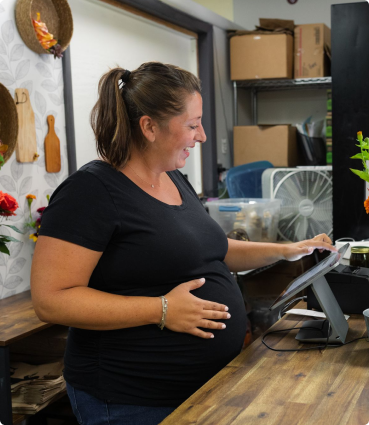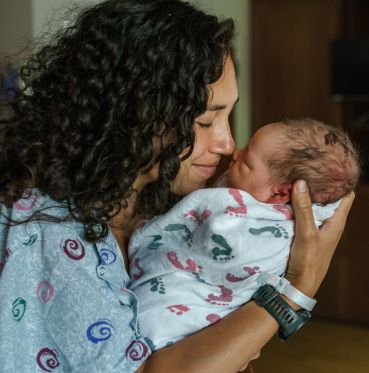Regardless of the way you are starting or expanding your family you may be eligible for up to 12 weeks of paid leave benefits.
You also may qualify for an extra 2 weeks, for a total of 14 weeks if you experience a serious health condition during your pregnancy.
Paid leave in connection with pregnancy and childbirth or caregiver leave, may be received on an intermittent, reduced schedule or block leave basis.
Paid leave in connection with bonding may be received on a block leave or, with employer approval, reduced schedule or intermittent leave basis. It must be used within 12 months of the birth, adoption or placement of the child.
Select the Way You are Starting or Expanding Your Family
The specific type of leave and timing of leave depends on how your family is expanding and your role in that expansion. Select the way you are starting or expanding your family below.
-
Pregnancy and Childbirth + Bonding
There are several different CT Paid Leave options that may be available to you in connection with pregnancy-related leave and/or bonding, depending upon your role.
Description
The parent who is/was pregnant.
Pregnancy/Childbirth
Your claim reason is pregnancy/childbirth.
Leave may be taken for the following reasons:
- Prenatal medical appointments*
- Pregnancy-related complications*
- Recovery from pregnancies that do not end in a live birth,
- Childbirth and delivery, and
- The “Recovery Period” –the period of time after the delivery during which the parent who was pregnant is certified by the healthcare provider as unable to perform the requirements for the parent’s job.
*Qualifies as a serious health condition during pregnancy, enabling you to access up to 2 additional weeks of paid leave benefits.
Bonding
Your claim reason is bonding leave.
Leave taken to allow a parent to develop a mutual emotional and psychological closeness with a new child.
The benefits can be taken as block leave or, with employer approval, as reduced schedule or intermittent leave.
Description
A parent of the new child who is also the spouse of the pregnant parent or is in a relationship with the pregnant parent that is equivalent to a marriage.
Pregnancy/Childbirth
Your claim reason is caregiver leave.
Leave taken to provide care and comfort to a spouse who is experiencing a serious health condition, including pregnancy/childbirth.
In connection with pregnancy/childbirth, caregiver leave may be taken for the following reasons:
- Attending prenatal medical appointments
- Caring for the spouse who is experiencing pregnancy-related complications
- Caring for the spouse who is recovering from pregnancies that do not end in a live birth
- Attending the childbirth and delivery, and
- Caring for the spouse during the "recovery period" - the period of time after the delivery during which the parent who was pregnant is certified by the healthcare provider as unable to perform the requirements for the parent's job
The benefits can be taken with intermittent, reduced schedule or block leave.
Bonding
Your claim reason is bonding leave.
Leave taken to allow a parent to develop a mutual emotional and psychological closeness with a new child.
The benefits can be taken with intermittent, reduced schedule or block leave.
Description
A parent of the newborn child who is not married to or in an equivalent relationship with the pregnant parent.
Pregnancy/Childbirth
If you are the parent of the child, but you are not married to or in an equivalent relationship with the pregnant parent, you cannot receive CTPL benefits to take caregiver leave during the pregnancy or post-delivery recovery period.
Bonding
Your claim reason is bonding leave.
Leave taken to allow a parent to develop a mutual emotional and psychological closeness with a new child.
An eligible employee may receive CTPL benefits in connection with leave to bond with the newborn child regardless of whether the employee is married to the child’s other parent.
The benefits can be taken as block leave or, with employer approval, as reduced schedule or intermittent leave.
Description
Family member of the pregnant parent.
Pregnancy/Childbirth
Your claim reason is caregiver leave to provide care and comfort to a family member who is experiencing a serious health condition, including pregnancy/childbirth.
In connection with pregnancy/childbirth, caregiver leave may be taken for the following reasons:
- Attending prenatal medical appointments
- Caring for the pregnant parent who is experiencing pregnancy-related complications
- Caring for the pregnant parent who is recovering from pregnancies that do not end in a live birth
- Attending the childbirth and delivery, and
- Caring for the pregnant parent during the "recovery period" - the period of time after the delivery during which the parent who was pregnant is certified by the healthcare provider as unable to perform the requirements for the parent's job
The benefits can be taken with intermittent, reduced schedule or block leave.
Bonding
If you are not the parent of the child (adoptive, step, foster, in loco parentis) you cannot take bonding leave.
Only the parent of the newborn child may receive CTPL benefits in connection with leave to bond with a newborn child.
-
Adoption + Bonding

Adoption means legally and permanently assuming the responsibility of raising a child as one's own.
Leave for adoption may be taken for the following reasons:
Pre-adoption activities
Absences required for the adoption to proceed, such as required counseling sessions, court appearances and travel to different localities.
For pre-placement activities, the parent can receive CT Paid Leave benefits in connection with the leave taken on an intermittent, reduced schedule or block basis.
Bonding with child upon legal adoption
Absences taken to allow a parent to develop a mutual emotional and psychological closeness with the child upon the legal adoption of the child.
For bonding upon the placement, the parent can receive CT Paid Leave benefits in connection with leave taken on a block basis or, with the employer's consent, on a reduced schedule or intermittent basis.
No matter when you start your bonding leave, it must be completed within 12 months of the child's adoption.
-
Foster Care + Bonding

Foster Care Placement is 24-hour care for children in substitution for, and away from, their parents or guardian. Such placements involve state action, voluntary or involuntary removal of the child from the parents or guardian, and an agreement between the state and foster family that the family will care for the child. Eligible employees may receive CT Paid Leave benefits in connection with leave taken for a foster care placement of any duration.
Leave for foster care placement may be taken for the following reasons:
Pre-placement activities
Absences required for the foster care placement to proceed, such as required counseling sessions, court appearances and travel to different localities;
For pre-placement activities, the parent can receive CT Paid Leave benefits in connection with the leave taken on an intermittent, reduced schedule or block basis.
Bonding with child upon placement
Absences taken to allow a parent to develop a mutual emotional and psychological closeness with the child upon the placement of the foster child.
For bonding upon the placement, the parent can receive CT Paid Leave benefits in connection with leave taken on a block basis or, with the employer's consent, on a reduced schedule or intermittent basis.
No matter when you start your bonding leave, it must be completed within 12 months of the child's placement in your home.
Important
If you experience a serious health condition that occurs during pregnancy but is not related to the pregnancy (such as a broken leg), you should file it as a serious health condition, not a pregnancy claim, but you should notify Aflac that you are pregnant so you can access the extra two weeks.
Pregnancy/Childbirth + Bonding Examples

Example 1
Pat is a Pregnant Parent experiencing severe morning sickness during pregnancy and uses two weeks of benefit allotment (2 weeks available for a serious health condition during pregnancy).
Pat returns to work until the baby is born. After the birth, Pat uses 6 weeks of benefit allotment to recover from the birth. (6 weeks for pregnancy/childbirth).
Pat returns to work. When the child is 6 months old, Pat elects to use the remaining 6 weeks of benefits to bond with the child. (6 weeks for bonding).
Pat has received 14 weeks total (2 during pregnancy, and 12 after the child’s birth) of CT Paid Leave benefits and has no weeks remaining.
Example 2
Lee is a Married/Equivalent Parent who takes 3 weeks immediately following the child's birth to provide care for the Pregnant Parent (3 weeks of caregiver leave).
Lee returns to work.
Two months later, Lee takes 9 weeks of bonding leave.
Lee has received 12 weeks total of CT Paid Leave benefits and has no weeks remaining.



Example 3
Chris is a Pregnant Parent who uses 1 week total during the pregnancy, taken as intermittent leave, for income replacement for routine pre-natal appointments.
After Chris gives birth via cesarean section, the healthcare provider tells Chris to take 8 weeks to recover from the birth. (8 weeks for pregnancy/childbirth).
Chris does not return to work after the 8 weeks and immediately uses the remaining 4 weeks for bonding.
Chris has received a total of 13 weeks of CT Paid Leave benefit and has no weeks remaining.
No matter when you start your bonding leave, it must be completed within 12 months of the child's birth.



